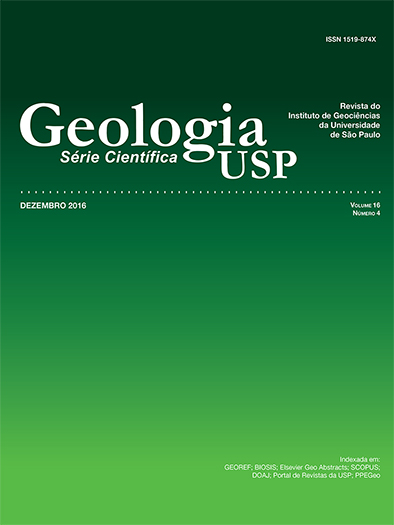Mesozoic phytoclast records in the Sriperumbudur (Palar Basin), Kota (Chintalapudi Sub-Basin) and Dubrajpur (Rajmahal Basin) formations, India
DOI:
https://doi.org/10.11606/issn.2316-9095.v16i4p119-134Keywords:
Fossilized cuticle, Fossilized stomata, Fossilized parenchyma, Jurassic, Cretaceous, India.Abstract
The studies of fossil plant cuticles in palynological samples recovered from three cored boreholes located in the Indian states of Andhra Pradesh (Kota/Gangapur Formation, Chintalapudi Sub-basin, Godavari Graben, Jurassic–Cretaceous), Tamil Nadu (Sriperumbudur Formation, Palar Basin, Upper Jurassic–lowermost Cretaceous), and Jharkhand (Dubrajpur Formation, Rajmahal Basin, Upper Jurassic–Lower Cretaceous) are presented herein. Cuticles and palynomorphs were recovered by standard palynological practices in the Gondwana Palynological Laboratory of the Birbal Sahni Institute of Palaeosciences, Lucknow, India. Fossil specimens were examined under a binocular microscope and photomicrographs were taken with a digital camera. Twenty seven morphotypes of fossil cuticles (occasionally representing stomata, trichomes and secretory structures) and other tissues (e.g., a plicate parenchyma) were recovered. The morphological analysis of cuticles and associated palynomorphs reflect the presence of different groups of plants (Bennettitales, Coniferales, Ginkgoales, Polypodiales, and Pteridospermales). In some occasions, cuticles display distinct structures (e.g., monocyclic stomata, secretory structures) that allow comparisons with some extant and fossil genera. We conclude that the study of well-preserved fossil cuticles and associated palynomorphs allow taxonomic inferences on the composition of the parent floras.
Downloads
Published
Issue
Section
License
Authors who publish in this journal shall comply with the following terms:
- Authors keep their copyright and grant to Geologia USP: Série Científica the right of first publication, with the paper under the Creative Commons BY-NC-SA license (summary of the license: https://creativecommons.org/licenses/by-nc-sa/4.0 | full text of the license: https://creativecommons.org/licenses/by-nc-sa/4.0/legalcode) that allows the non-commercial sharing of the paper and granting the proper copyrights of the first publication in this journal.
- Authors are authorized to take additional contracts separately, for non-exclusive distribution of the version of the paper published in this journal (publish in institutional repository or as a book chapter), granting the proper copyrights of first publication in this journal.
- Authors are allowed and encouraged to publish and distribute their paper online (in institutional repositories or their personal page) at any point before or during the editorial process, since this can generate productive changes as well as increase the impact and citation of the published paper (See The effect of Open Access and downloads on citation impact).





